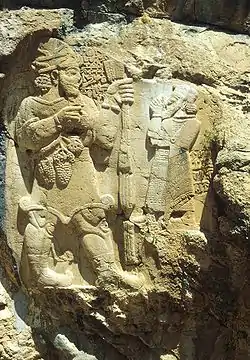Tuwana
Tuwana (Akkadian Tuḫana) was an Iron Age Luwian kingdom in southern Anatolia, one of the Syro-Hittite states, which existed in southeastern Anatolia in the 8th century BC.

Location
Tuwana occupied roughly the same area as the later region of Tyanitis. The name derives from the earlier city of Tuwanuwa in the "Lower Land" of the Hittite empire in the 2nd millennium BC, which was subsequently known as Tyana in the Hellenistic and Roman periods and is now the town of Kemerhisar in Niğde Province, Turkey. This town was presumably the capital of Tuwana. In the south, the kingdom extended to the Cilician Gates and the kingdom of Quwê. In the north lay the region of Tabal, which is sometimes considered part of Tuwana.
History
In the second half of the 8th century BC, Warpalawas II, son of Muwaharani I was king in Tuwana. At this time, Tabal and Tuwana were tributaries of the Assyrian Empire of Tiglath-Pileser III. Simultaneously, strong influence from the kingdom of Mushki, ruled by King Mita (who is often identified with Midas of Phrygia, known from Greek sources) is evident. The Phrygian evidence is seen in two Old Phrygian inscriptions, which were found in Kemrhisar, and by bronze objects of clear Phrygian origin in a tumulus at Kaynarca, seven kilometres northeast of Tyana. In a letter of 715 BC, Sargon II describes how King Mita of Mushki had sent emissaries to the Assyrian governor in Quwê, Ašur-Šarru-Usur, asking for an exchange of ambassadors. The accompanying ambassadors of Warpalawas II (Akkadian: Urballa) are there described as messengers of one of Mita's vassals. A report of Ašur-Šarru-Usur to Sargon II indicates that Warpalawas conquered Bit Burutaš (part of Tabal) in 713 BC after King Ambaris of Tabal had been deposed and deported to Assyria. İvriz relief a stele of Tarḫunz with a Luwian-Phoenician bilingual text, which was found in 1986, shows that the North-Syrian Aramaic cultural area had a strong influence on the area as well. The Niğde Stele, which was erected by Warapalawas’ son, Muwaharani II, is clearly modelled on Assyrian steles. In the subsequent period, when both the Phrygian kingdom and the kingdom of Urartu to the east fell to the Cimmerians, there are no further traces of Tuwana.
Rulers[1][2]
- Warpalawas I (early 8th century BC)
- Saruwani I (mid-8th century BC)
- Muwaharani I (ca. 740)
- Warpalawas II (ca. 740-705)
- Muwaharani II (End of the 8th century BC)
References
- Trevor Bryce: The World of the Neo-Hittite Kingdoms; A Political and Military History. Oxford, New York 2012, pp. 148-152, 307.
- Christian Marek, Peter Frei: Geschichte Kleinasiens in der Antike. München 2010, p. 802.
Bibliography
- Dietrich Berges, "Die Frühgeschichte Tyanas." In Dietrich Berges, Johannes Nollé, Tyana. Archäologisch-historische Untersuchungen zum südwestlichen Kappadokien. Rudolf Habelt Verlag, Bonn 2000, ISBN 3-7749-2959-9, pp. 465–475.
- Tuwana. in Trevor Bryce, The Routledge Handbook of The People and Places of Ancient Western Asia. The Near East from the Early Bronze Age to the fall of the Persians Empire. Routledge, Abingdon 2009, ISBN 978-1-134-15908-6, p. 726 (on Google Books).